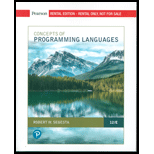
EBK CONCEPTS OF PROGRAMMING LANGUAGES
12th Edition
ISBN: 9780135102251
Author: Sebesta
Publisher: VST
expand_more
expand_more
format_list_bulleted
Textbook Question
Chapter 3, Problem 1PS
The two mathematical models for language description are:
- Recognition
- Generation
These two mathematical models can define the syntax of
Recognition:
- It works on yes or no basis. In this method, a
mechanism called recognition device (R) is used that can read strings from the given alphabet. - This would indicate whether the input string is in language or not. That means, it will either accept the string or reject the string.
- Recognition device filters the correctly formed sentences from those that are incorrectly formed.
- In recognition, recognizer is used for syntax. analysis. Recognizer does not check for all possible strings but it simply check if the given programs are in the language or not.
- It checks the syntactical part of the program.
Generation:
- In this method, a device named generator is used to generate the sentences in a language.
- Whenever a generator is called, it generator a sentence which is unpredictable.
- When a string is to be checked if it is a correct or incorrect, first of all, it calls the generator to generate a correct sentence.
- Then, it compares the correct generated string with the input string.
- Hence, it determines the correction in string.
Expert Solution & Answer
Want to see the full answer?
Check out a sample textbook solution
Students have asked these similar questions
4. |z + 5 - 5i| = 7
14.
dz,
C: |z❘
C: |z❘ = 0.6
ze² - 2iz
H
14.
dz,
C: |z❘
C: |z❘ = 0.6
ze² - 2iz
H
Chapter 3 Solutions
EBK CONCEPTS OF PROGRAMMING LANGUAGES
Ch. 3 - Prob. 1RQCh. 3 - Prob. 2RQCh. 3 - Prob. 3RQCh. 3 - Prob. 4RQCh. 3 - Prob. 5RQCh. 3 - Prob. 6RQCh. 3 - Prob. 7RQCh. 3 - Prob. 8RQCh. 3 - Prob. 9RQCh. 3 - What is the difference between a synthesized and...
Ch. 3 - Prob. 11RQCh. 3 - Prob. 12RQCh. 3 - Prob. 13RQCh. 3 - Prob. 14RQCh. 3 - Prob. 15RQCh. 3 - Prob. 16RQCh. 3 - Prob. 17RQCh. 3 - Prob. 18RQCh. 3 - Prob. 19RQCh. 3 - Prob. 20RQCh. 3 - Prob. 21RQCh. 3 - What does partial correctness mean for a loop...Ch. 3 - Prob. 23RQCh. 3 - Prob. 24RQCh. 3 - Prob. 25RQCh. 3 - Prob. 26RQCh. 3 - Prob. 27RQCh. 3 - Prob. 28RQCh. 3 - Prob. 29RQCh. 3 - The two mathematical models for language...Ch. 3 - Write EBNF descriptions for the following: a. A...Ch. 3 - Prob. 3PSCh. 3 - Prob. 4PSCh. 3 - Prob. 5PSCh. 3 - Prob. 6PSCh. 3 - Prob. 9PSCh. 3 - Prob. 10PSCh. 3 - Prob. 12PSCh. 3 - Prob. 15PSCh. 3 - Prob. 16PSCh. 3 - Prob. 17PSCh. 3 - Prob. 18PSCh. 3 - Compute the weakest precondition for each of the...
Additional Engineering Textbook Solutions
Find more solutions based on key concepts
What is the advantage of making frequent checkpoints of a database?
Database Concepts (8th Edition)
What is thermal cutting?
Degarmo's Materials And Processes In Manufacturing
Write an IfThen statement that prints the message The number is not valid if the variable sngSpeed is outside t...
Starting Out With Visual Basic (8th Edition)
Modify Problem and Exercise 6-60 so that the list includes the number of products each customer bought in each ...
Modern Database Management
If you have a PC, record the sequence activities that you can observe when you turn it on. Then determine what ...
Computer Science: An Overview (13th Edition) (What's New in Computer Science)
1. Read the problem statement. 2. Formulate the algorithm using pseudocode and top-down, stepwise refinement. 3...
Java How to Program, Early Objects (11th Edition) (Deitel: How to Program)
Knowledge Booster
Learn more about
Need a deep-dive on the concept behind this application? Look no further. Learn more about this topic, computer-science and related others by exploring similar questions and additional content below.Similar questions
arrow_back_ios
SEE MORE QUESTIONS
arrow_forward_ios
Recommended textbooks for you
- Programming Logic & Design ComprehensiveComputer ScienceISBN:9781337669405Author:FARRELLPublisher:Cengage
 C++ Programming: From Problem Analysis to Program...Computer ScienceISBN:9781337102087Author:D. S. MalikPublisher:Cengage LearningNp Ms Office 365/Excel 2016 I NtermedComputer ScienceISBN:9781337508841Author:CareyPublisher:Cengage
C++ Programming: From Problem Analysis to Program...Computer ScienceISBN:9781337102087Author:D. S. MalikPublisher:Cengage LearningNp Ms Office 365/Excel 2016 I NtermedComputer ScienceISBN:9781337508841Author:CareyPublisher:Cengage  EBK JAVA PROGRAMMINGComputer ScienceISBN:9781337671385Author:FARRELLPublisher:CENGAGE LEARNING - CONSIGNMENT
EBK JAVA PROGRAMMINGComputer ScienceISBN:9781337671385Author:FARRELLPublisher:CENGAGE LEARNING - CONSIGNMENT Microsoft Visual C#Computer ScienceISBN:9781337102100Author:Joyce, Farrell.Publisher:Cengage Learning,
Microsoft Visual C#Computer ScienceISBN:9781337102100Author:Joyce, Farrell.Publisher:Cengage Learning,

Programming Logic & Design Comprehensive
Computer Science
ISBN:9781337669405
Author:FARRELL
Publisher:Cengage

C++ Programming: From Problem Analysis to Program...
Computer Science
ISBN:9781337102087
Author:D. S. Malik
Publisher:Cengage Learning

Np Ms Office 365/Excel 2016 I Ntermed
Computer Science
ISBN:9781337508841
Author:Carey
Publisher:Cengage

EBK JAVA PROGRAMMING
Computer Science
ISBN:9781337671385
Author:FARRELL
Publisher:CENGAGE LEARNING - CONSIGNMENT


Microsoft Visual C#
Computer Science
ISBN:9781337102100
Author:Joyce, Farrell.
Publisher:Cengage Learning,
Structured Chart; Author: Tutorials Point (India) Ltd.;https://www.youtube.com/watch?v=vdUO-sGA1DA;License: Standard YouTube License, CC-BY
Introduction to Structure Charts; Author: Christopher Kalodikis;https://www.youtube.com/watch?v=QN2bjNplGlQ;License: Standard Youtube License